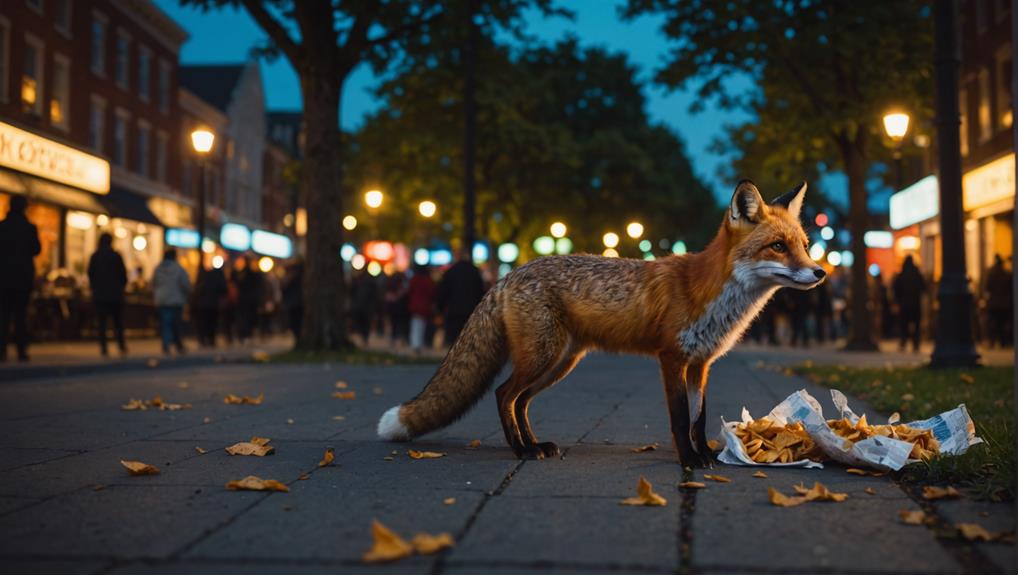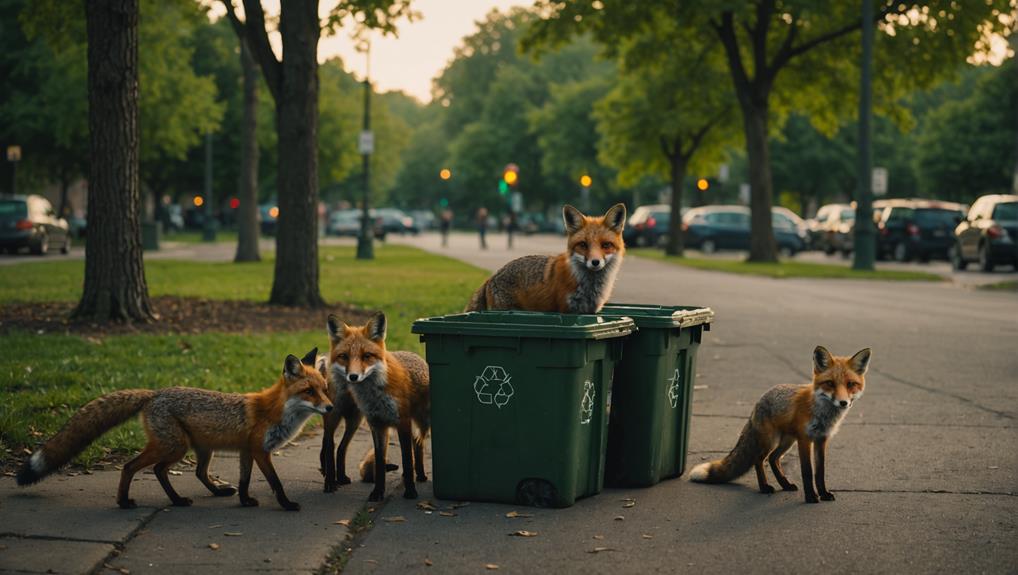About 70% of urban foxes are thriving in cities, proving they're much more adaptable than we might think! These clever critters have found cozy homes in gardens and sheds, and they've learned to feast on both food scraps and small prey. With their bold personalities, urban foxes explore every nook and cranny, making the most of city life. They're not just surviving; they're actually helping keep pesky rodents at bay! While their presence can raise some eyebrows, understanding their behavior can ease concerns. Stick around, and you might discover some neat ways to peacefully coexist with these furry neighbors!
Contents
Urban Adaptation of Fox Species
Urban foxes have shown an impressive ability to adapt to city life, with studies revealing that about 50% of their diet consists of household waste. Isn't it fascinating how these clever critters have figured out that urban environments offer an abundance of food?
The urban fox populations have soared in the UK, jumping from 33,000 in 1995 to a whopping 150,000 by 2017! It's a clear sign that they're thriving among us, even if they took a little dip in numbers in 2018.
These urban foxes act bolder than their country cousins, often investigating new objects and interacting with their surroundings more eagerly. You might find them curling up in your garden or nesting under your shed—talk about making themselves at home!
Their adaptability not only showcases their cleverness but also reminds us how wildlife can thrive in our busy lives. They're like tiny reminders that nature has a place in our concrete jungles.
Habitat Preferences in City Environments
In cities, foxes have developed specific habitat preferences that reflect their remarkable adaptability. You might be surprised to learn that these clever creatures thrive in various urban environments, not just the outskirts of town. They've been spotted in urban areas since the 1930s, making homes under sheds, in bushes, or even among tree roots.
These dens provide safe spaces for raising their adorable cubs, showing just how resourceful they can be.
As urban development continues, the number of urban foxes has skyrocketed from 33,000 in 1995 to around 150,000 in 2017. This suggests they're really settling into city life.
The arrangement of housing plays a significant role in their populations, and you might even find them wandering around city centers, proving their ability to adapt to the hustle and bustle of human life.
Behavioral Shifts in Urban Foxes

Foxes living in cities have shown fascinating behavioral shifts that underline their adaptability. These urban foxes are becoming bolder, often approaching new food-related objects without hesitation. Imagine them sniffing around your trash cans, eagerly exploring the treasures inside! This behavioral flexibility is crucial, allowing them to thrive in a world dominated by humans.
You might be surprised to learn that around half of their diet now includes household refuse, in addition to their usual prey. Talk about resourcefulness! Urban foxes are clever critters, using human-modified landscapes for shelter and breeding. They often find cozy dens in gardens or under sheds, making the most of their urban surroundings.
Interestingly, while urban foxes love to poke at unfamiliar items, they don't always come up with innovative solutions to problems. It's like having a curious friend who's great at finding snacks but struggles with puzzles.
Still, these remarkable animals can self-regulate their populations based on available territory and food, showing just how well they adapt. As we learn more about their behaviors, we can appreciate the unique ways they navigate the challenges of city life. Isn't nature just incredible?
Dietary Adjustments for City Living
Urban foxes really know how to make the best of city life, don't they?
Instead of sticking to a strict meat diet like their rural cousins, they've adapted to munch on about half meat and half whatever tasty leftovers they can find in trash bins.
With a knack for scavenging and a flexible palate, these clever critters manage to thrive, proving that even in the hustle and bustle of city living, a good meal is never too far away!
Food Scavenging Behavior
Adapting to city life, urban foxes have cleverly adjusted their diets to thrive in environments filled with human food sources. In urban areas, these resourceful creatures balance their meals with about 50% meat and 50% household refuse. You might spot them scavenging through garbage bins, looking for tasty leftovers, though their reliance on waste is sometimes a bit exaggerated.
Interestingly, urban foxes show more dietary flexibility than their rural relatives, who mainly feast on meat, insects, and fruits. With so many food options available, urban foxes have become quite the culinary adventurers. Plus, many kind-hearted residents contribute by intentionally feeding them—about 10% of households in Bristol do just that!
Here's a quick look at their food sources:
| Food Source | Percentage | Description |
|---|---|---|
| Meat | 50% | Small mammals, birds, and insects |
| Household Refuse | 50% | Leftovers, pet food, and scraps |
| Intentionally Fed | 10% | Food provided by residents |
| Scavenging | Common | Rummaging through bins and streets |
These clever scavengers remind us of the resilience of nature, even in the hustle and bustle of urban life!
Adaptable Dietary Preferences
In bustling city environments, the dietary preferences of urban foxes have shifted significantly to accommodate the unique availability of food. You might be surprised to learn that these clever creatures have become quite the foodies! Their diets now consist of about 50% meat and 50% household refuse, a far cry from their rural cousins who munch on nearly all meat.
Here are some interesting ways urban foxes adapt their eating habits:
- Scavenging from garbage bins is a favorite pastime.
- Many residents (about 10%) actively feed them, creating food surpluses.
- They hunt birds and small mammals, helping keep rodent populations in check.
- Animal-proof bins haven't deterred them, showing their resilience.
- Urban areas have become a buffet of options, thanks to our leftovers!
The presence of foxes in these urban areas since they've adapted shows just how resourceful they can be.
So, the next time you see a fox rummaging through your trash, remember, they're just trying to make the best of city living!
Who knew urban foxes could teach us a thing or two about adaptability?
Interactions Between Humans and Urban Foxes

Interactions between humans and urban foxes can often be complex and multifaceted. As you stroll through your neighborhood, you might spot a fox rummaging through the trash. These clever creatures adapt to urban life, relying on about 50% household refuse for their meals.
While it's fascinating to see foxes living among us, it also raises health concerns, like the potential spread of diseases. So, managing these interactions with humans is crucial.
You can help by securing your trash bins and avoiding leaving pet food outside. This simple action reduces conflicts and keeps your furry friends safe. Plus, educating yourself and your neighbors about fox behavior can foster a sense of understanding. When people know why foxes are scrounging around, fear tends to melt away, paving the way for a peaceful coexistence.
With around 430,000 foxes in the UK—one fox for every 150 people—we're sharing our urban spaces with these wild neighbors. Embracing this connection can enhance wildlife conservation efforts and create a sense of community.
After all, wouldn't you rather share your space with a charming fox than worry about your trash?
The Role of Urban Planning in Fox Habitats
How can urban planning enhance the habitats of urban foxes?
It's all about creating spaces where both humans and wild animals can thrive together.
By thoughtfully designing our cities, we can help foxes live comfortably among us.
Here's how urban planning can make a difference:
- Green spaces like parks and gardens provide essential habitats for foxes.
- Wildlife corridors allow foxes to move freely and access food sources without hassle.
- Low-density suburban areas with yards mimic natural environments, supporting fox survival.
- Human-made structures, such as sheds, can serve as cozy dens for our furry friends.
- Educational programs raise awareness about cohabitating with wildlife, easing potential conflicts.
Strategies for Coexistence and Conservation

When it comes to living alongside urban foxes, a few simple strategies can make a world of difference.
By securing your trash bins and not leaving pet food outside, you'll help keep these clever critters from rummaging through your backyard.
Plus, getting involved in community efforts to preserve their habitats not only benefits foxes but also connects you with your neighbors in a fun and meaningful way!
Conflict Prevention Techniques
Living in close proximity to urban foxes can be a rewarding experience, but it also requires a proactive approach to minimize conflicts.
By taking simple steps, you can foster a harmonious relationship with these clever critters and help keep your community safe.
Here are some effective conflict prevention techniques:
- Secure trash bins and compost containers with animal-proof lids.
- Keep outdoor pet food indoors to eliminate attractants.
- Educate yourself and your neighbors about the minimal threat urban foxes pose to humans.
- Encourage community involvement in wildlife management initiatives.
- Use non-toxic repellents approved for urban environments.
Habitat Preservation Efforts
Urban areas can thrive with the presence of foxes, but preserving their habitats is essential for fostering coexistence and conservation. You can make a difference by securing trash bins and avoiding leaving pet food outside. This simple act reduces those pesky urban fox attractants, keeping both you and the foxes safer.
Community education plays a vital role, too. When you understand urban fox behavior, it fosters greater tolerance and helps everyone coexist harmoniously. Innovative conservation strategies, like humane management and habitat enhancement, support urban fox populations while ensuring your safety isn't compromised.
One of the most effective ways to help is by promoting wildlife corridors. By preserving natural habitats in urban areas, you not only support urban foxes but also maintain ecological balance for various species. Imagine a little fox darting through a corridor—it's like a mini nature park right in your neighborhood!
Encouraging community involvement in biodiversity programs can strengthen local support for urban fox conservation. Together, you and your neighbors can create a welcoming environment for these clever creatures.
Final Thoughts
So there you have it—urban foxes are really making city life work for them! They've adapted their habits, found new food sources, and even learned to dodge our busy sidewalks. It's a wild world out there, and these clever critters remind us that nature can thrive, even in the hustle and bustle of urban life. By understanding and respecting their space, we can all share our cities a little more harmoniously. Who knew city living could be so foxy?














